|
Rag Days and fund raising
Fund raising for various good causes in Bourne has
always been well supported and carnival parades were a popular event in
the years following the Great War of 1914-18.
One of the earliest recorded was in 1925 when a grand parade was
held through the town with floats depicting local themes such as Hereward
the Wake and national events of the time. Most organisations took part
with local businesses lending horses and carts and even lorries to carry
the various tableaux through the streets, many designed by Alfred Stubley,
a painter and decorator from West Street who also specialised in scenic
design and was always ready to help with community events.
Events were soon being held annually, later taking the form of a rag day,
the first of which was staged in the summer of 1929 to raise funds for the
Butterfield Hospital. It was held on Saturday 6th July after several weeks
of organising, the initiative having been taken by Councillor Tom Rickard,
chairman of Bourne Urban District Council.
Heavy rain on the previous two days which continued into Saturday morning
threatened to spoil the event but the storm clouds disappeared as the main
parade started and the weather was fine, despite a strong wind. Crowds
thronged the streets, attracted by the main attraction of Lady Godiva
astride a horse, although her identity was never revealed. The procession
began in Mill Drove, headed by the Bourne Town Band and a float devoted to
safety first followed by the fire brigade and a float displaying new
equipment from the hospital, a baby's cot and bed from one of the wards
with a sister and nurse standing by. A barrel organ on a lorry came next,
blaring out music as it went, and this was followed by matron and sisters
from the hospital together with some trainee nurses.
There were many other tableaux, all heartily cheered as the procession
wound its way through the town to the market place then down Abbey Road,
Eastgate and back to town via Willoughby Road.
The procession was again reformed in the evening and this time took a
different route down North Street to the Market Place with several new attractions, notably Mr G Chamber, who was almost six
feet tall, riding a bicycle suitable for a child of six or seven. On each
occasion, helpers were out with their collecting tins to raise money for
the hospital with Messrs Wherry and Sons providing office space at their
North Street shop for the money to be counted until taken to the NFU Bank
later in the evening.
The procession dispersed about 7 pm but the band continued playing
selections in the market place as collectors walked about still rattling
their tins. Earlier in the week, sections of the parade had visited the
surrounding villages of Thurlby, Langtoft, Baston, Tongue End, Morton,
Edenham and Grimsthorpe with the barrel organ providing a musical
accompaniment on each trip.
"The hospital rag was an eminent success", reported the Stamford
Mercury the following Friday, "and the appeal to the general public to
help with funds received a ready response."
A glance through the list of tableaux which joined the procession with the
names of the organisers and helpers is an indication of the enthusiasm
among the various groups that took part:
Pinxton Colliery (Mr J G James); Safety First; Lady Godiva (Mr H G Penfold);
Fire Brigade (Mr J Moisey); Sunflowers (Mrs Reedman); Red Indians (Master
J Paine on horseback); Scout Troop (Assistant Scoutmaster G Lloyd);
hospital cot (Mrs J B Sibbald and baby); picnic (Mrs N Walker); hospital
organ (Matron and sister); Britannia and the Empire (Misses Dent and
Jackson); Jazz Band (Mr Williamson); peasants of many lands, Dickens'
tableaux; Queen Elizabeth and her courtiers (Misses Dent and Jackson);
barrel organ (Messrs J E Lunn, junior, and P Clark); Harry Tate, Mrs Tate
and Little Tate (Mr Thomas, Mr J Fields, aged 75, and Mr R Day, aged 72);
man in disguise (Mr R Greenfield); Boys of the Old (Fire) Brigade (Mr T
Stevenson); boy on stilts (Master J Raynor); scarecrow (Junior
Conservatives); minstrel troupe (Mr J Ross and others); cockerel (Master N Garfoot); Cupid (Master P Hind); Red Indian (Master L Hind); cowboy
(Master P Rose); nurse (Miss E Markham); gypsies (Misses E Robinson, O
Walker and E Moisey); letterbox (Miss D Nixon); gollywog on penny-farthing
bicycle (Mr L Stevenson); "Beck and Call" (Miss A Nixon); early Victorian
(Miss M Duffin); witch (Miss I Needham); Red Riding Hood (Miss M Rickard);
fairies (Misses P Stringer and S Pulford); and many others.
|
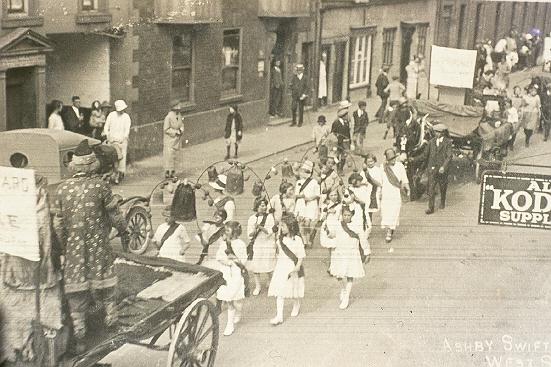 |
|
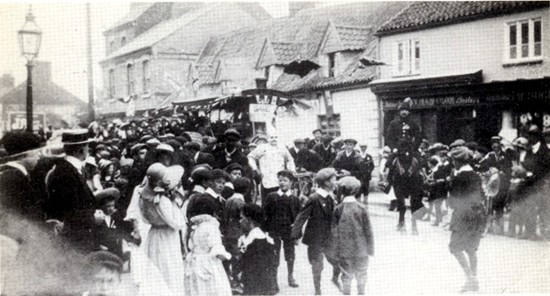 |
|
Two early charity parades are pictured above, from
1925 and 1928, and the 1929 procession with Lady Godiva which heralded the
start of the hospital rag days in aid of the Butterfield is pictured
below. |
|
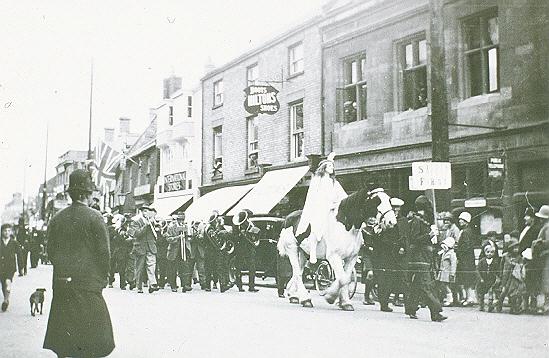 |
|
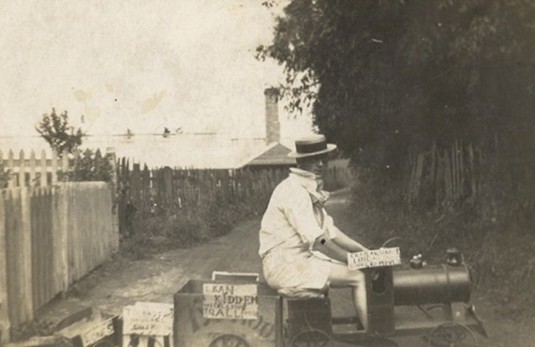 |
|
The events got bigger and better and these pictures have
survived from 1935 showing grown men doing silly things to raise money for
a good cause. |
|
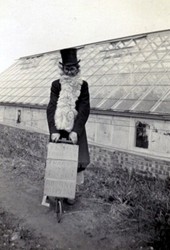 |
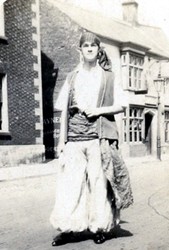 |
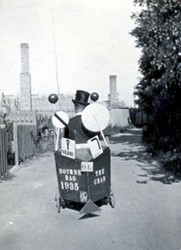 |
|
The following year, volunteers were still busy, this time
at Rippingale with a decorated lorry provided by a local haulage
contractor (below). |
|
 |
|
 |
|
HERE IS another old photograph taken on Rag Day
although the year is unknown. The character is meant to be John Bull, a
puny looking representative of our national hero, and I have established
that it was taken in the back garden of No 18 West Street, then a
private house but now used as office premises and known as Commerce
House. The location was fairly easy to identify by the windows of the
Baptist Church which can be seen in the background and so the house
frontage is on the left of the photograph.
The picture was taken by Ashby Swift (1882-1941), a Bourne photographer
who was in business from 1904, operating firstly from premises in South
Street and then across the road here in West Street.
It is obvious that the John Bull connection comes from the cycle tyres
which were known by that name, a popular brand in the early years of the
20th century, and samples can be seen hanging on the cart. Was he then a
cycle dealer? |
See also Alfred Stubley
Return to The Butterfield
Hospital

Go to:
Main Index Villages
Index
|







